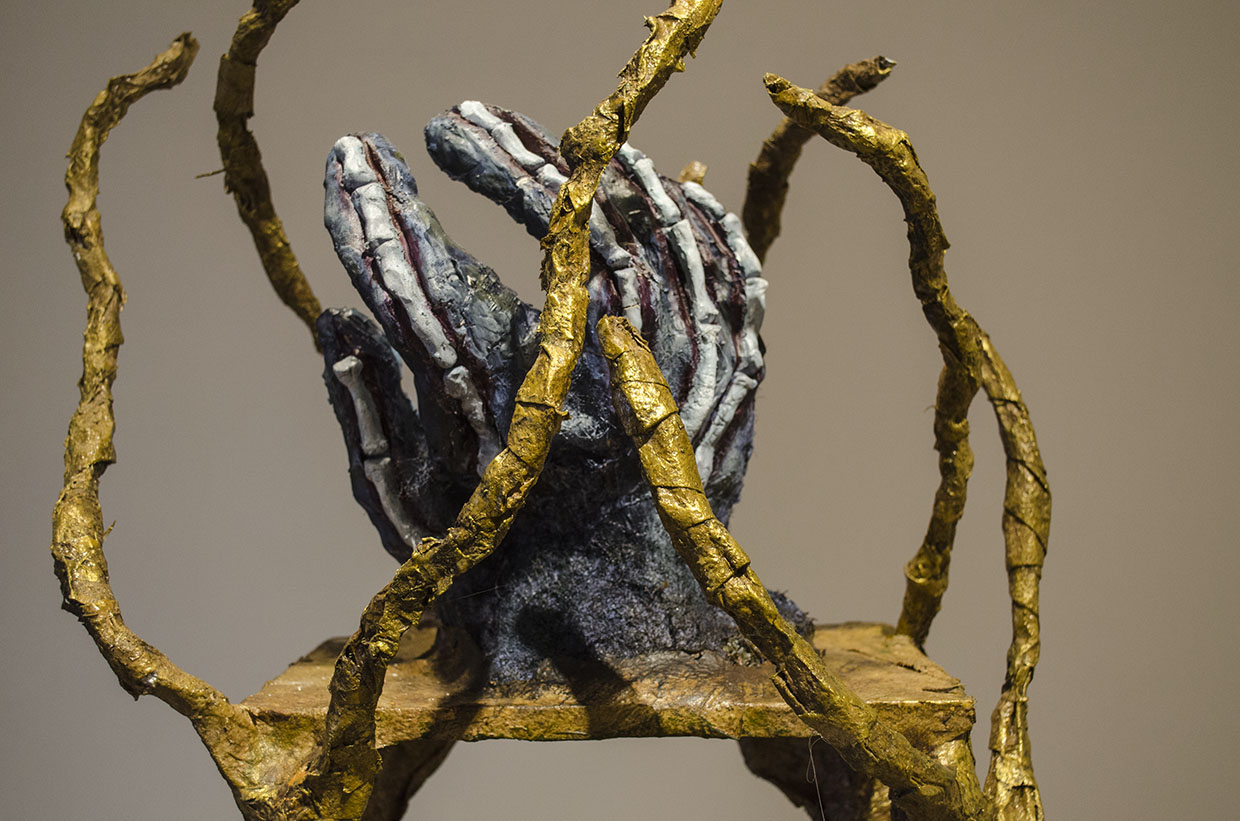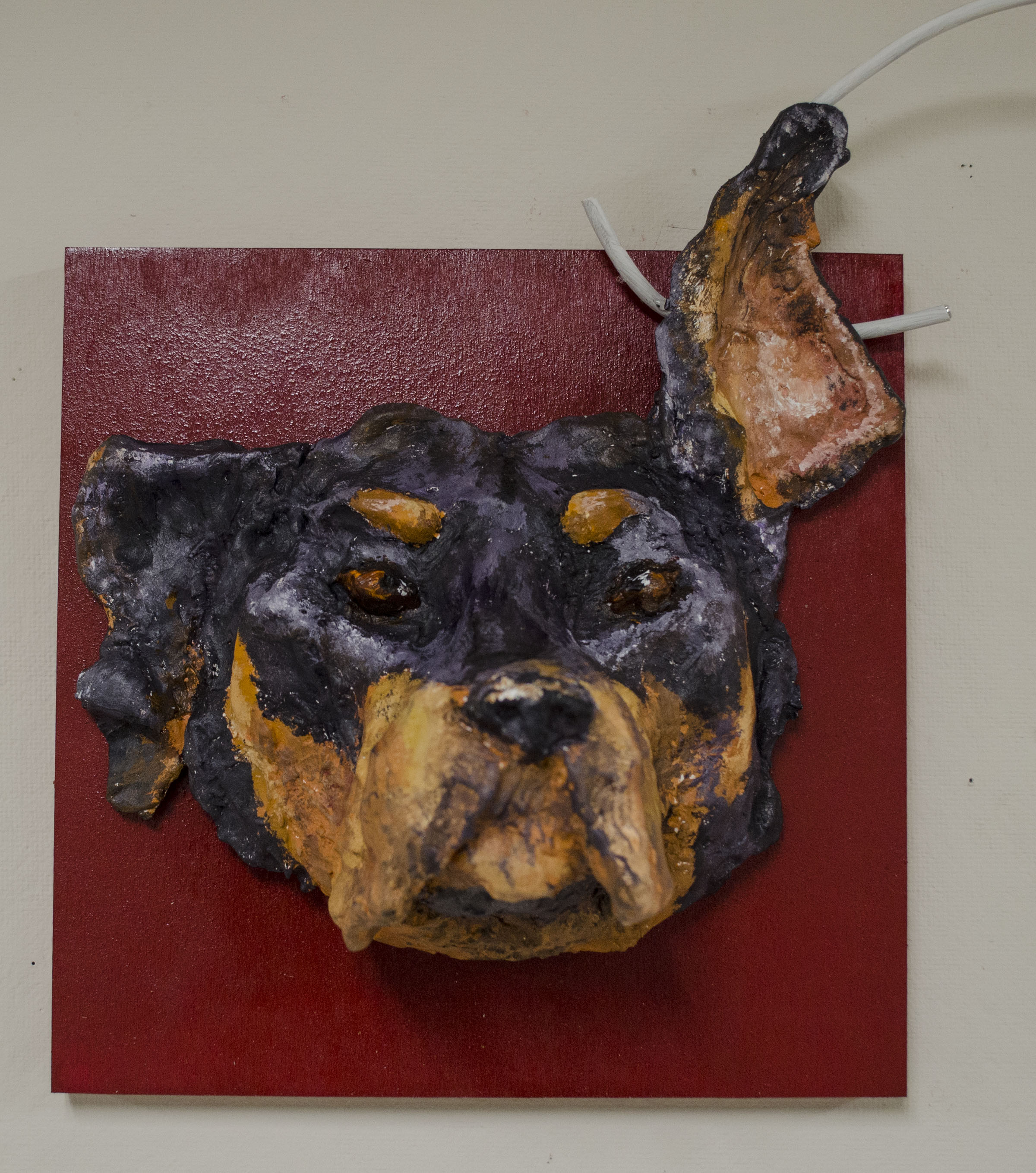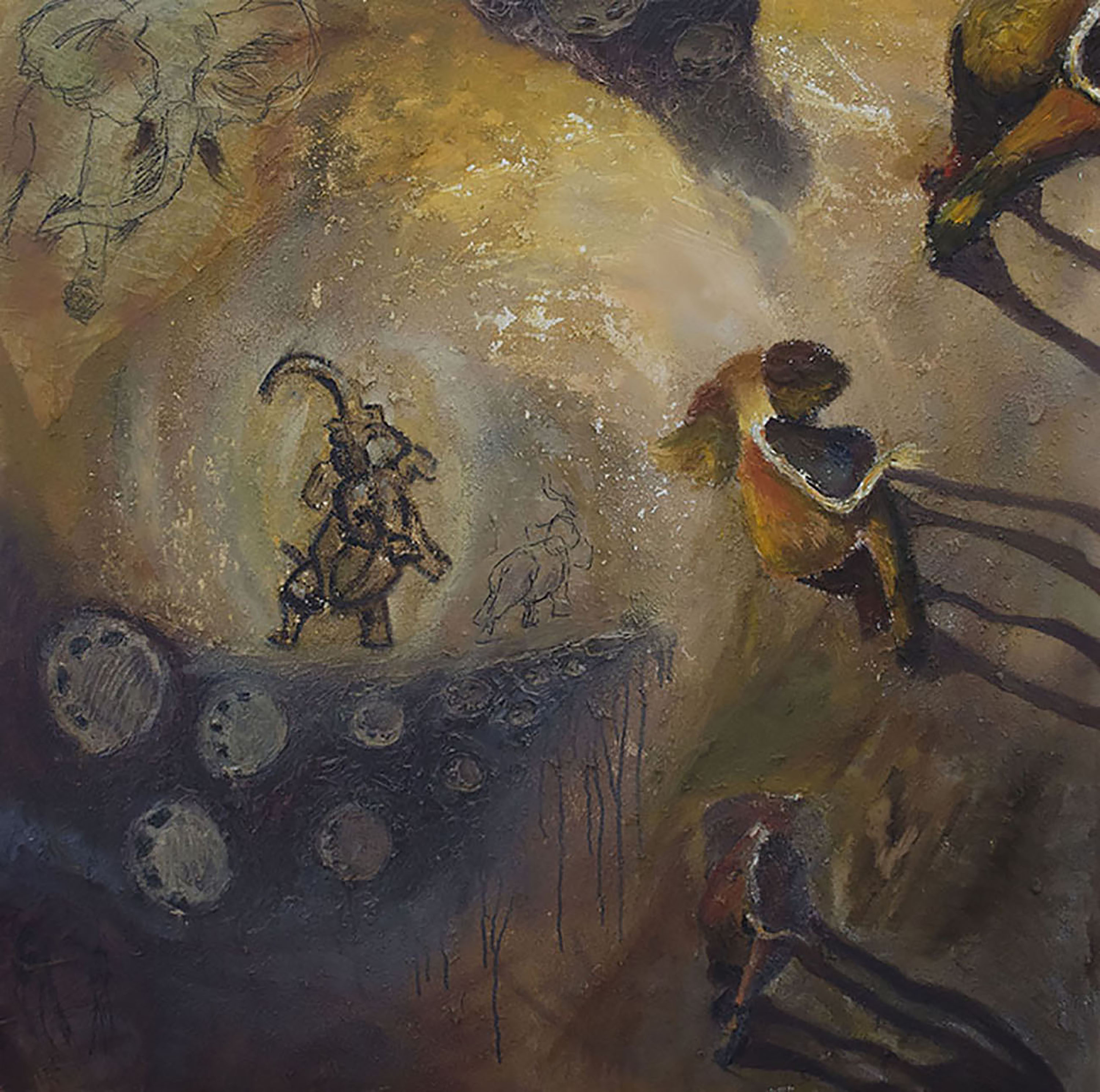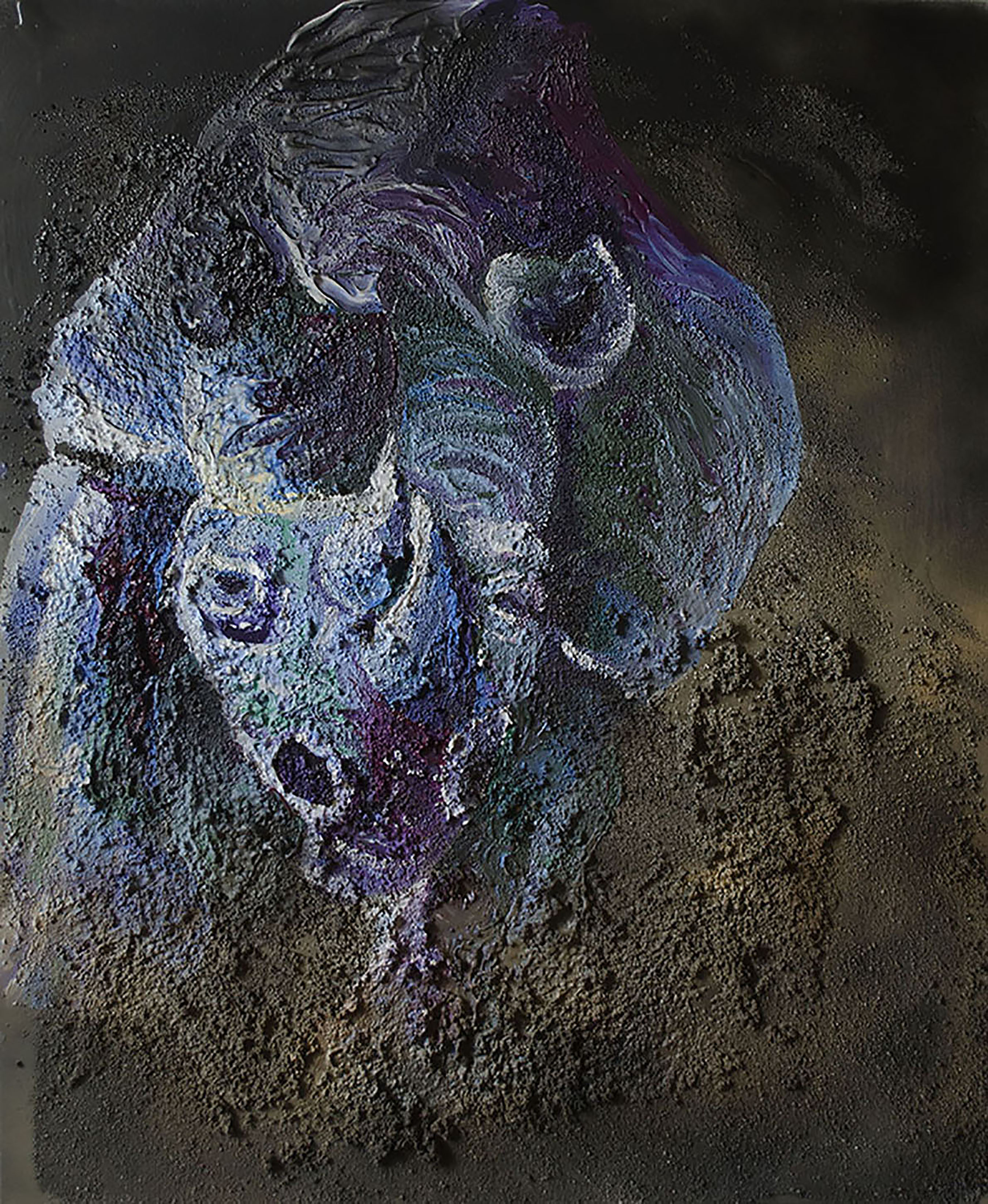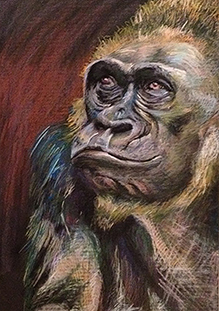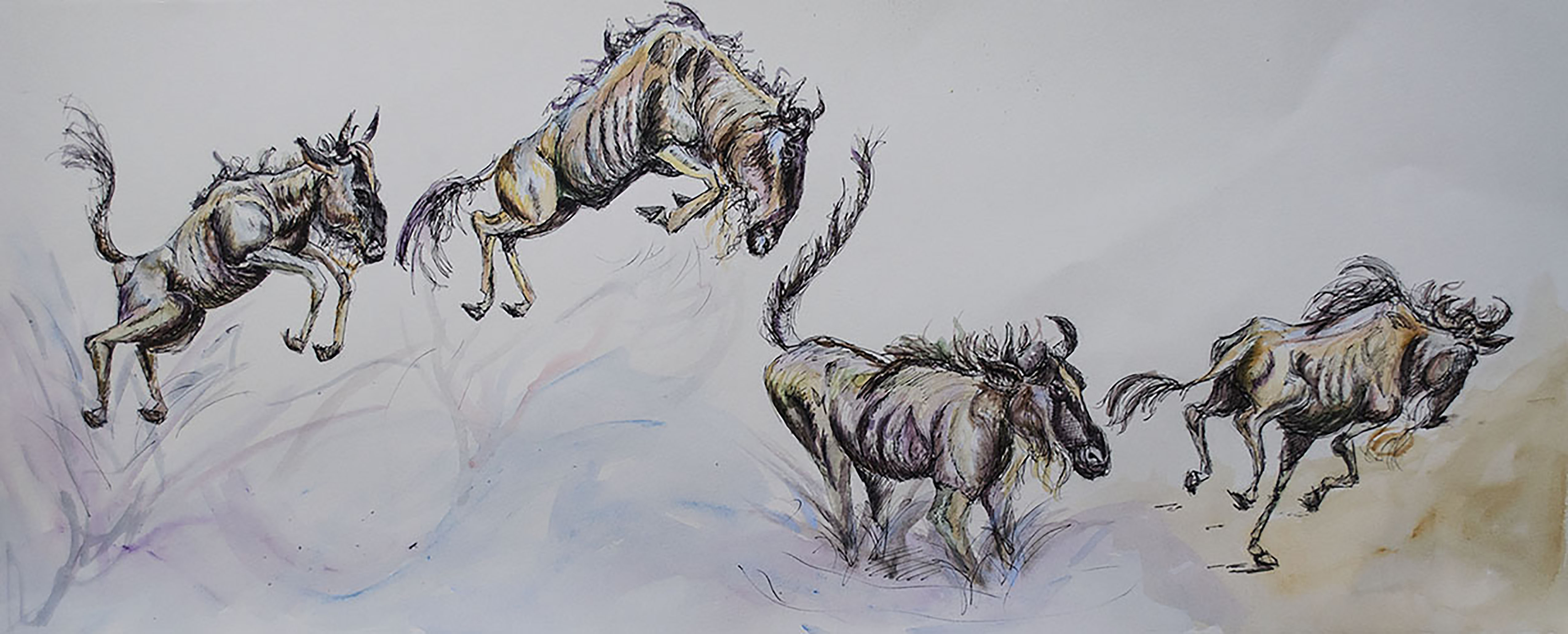About Emily
Baltimore City

Emily Tucci is a material-based sculptor focusing on issues of wildlife conservation and animal rights. She was born in Pennsylvania in 1994, and resides rural Chester County surrounded by farmland. She received her BFA in Fine Art and honors BA in Art History from University of Delaware in 2017. She moved to Baltimore and received her Post Baccalaureate in Fine Art Certificate from Maryland Institute College of Art in 2018, and is currently a graduate student there in the Rinehart School… more
Jump to a project:
Impala Trophy
Hunters display the animals they kill as a form of home decor, thus creating a trophy out of a once living creature. I have created a series of "trophies" that show how ingrained all elements of the creature are with each other with a focus on their anatomy. Elements of their natural environment are present within the piece, thus showing the integration of the animal within nature.
This piece represents the hunting of the African Impala for use of their horns.
-
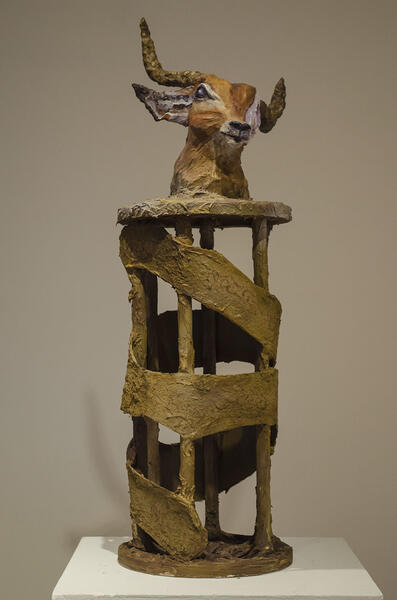 Impala TrophyHunters display the animals they kill as a form of home decor, thus creating a trophy out of a once living creature. I have created a series of "trophies" that show how ingrained all elements of the creature are with each other with a focus on their anatomy. Elements of their natural environment are present within the piece, thus showing the integration of the animal within nature. This piece represents the hunting of the African Impala for use of their horns. Wood, joint compound, clay, hand made paper made with dead leaves, acrylic, spray paint
Impala TrophyHunters display the animals they kill as a form of home decor, thus creating a trophy out of a once living creature. I have created a series of "trophies" that show how ingrained all elements of the creature are with each other with a focus on their anatomy. Elements of their natural environment are present within the piece, thus showing the integration of the animal within nature. This piece represents the hunting of the African Impala for use of their horns. Wood, joint compound, clay, hand made paper made with dead leaves, acrylic, spray paint -
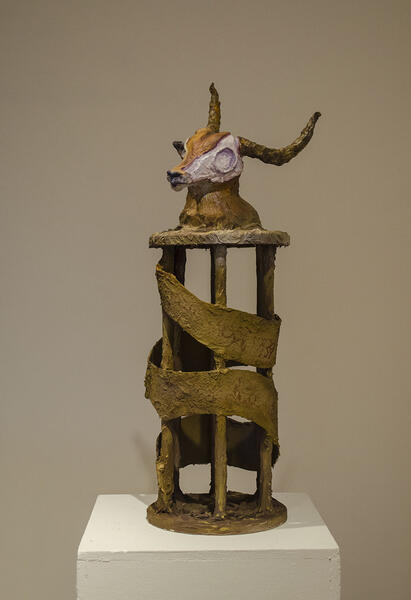 Impala Trophy (Detail)Hunters display the animals they kill as a form of home decor, thus creating a trophy out of a once living creature. I have created a series of "trophies" that show how ingrained all elements of the creature are with each other with a focus on their anatomy. Elements of their natural environment are present within the piece, thus showing the integration of the animal within nature. This piece represents the hunting of the African Impala for use of their horns.
Impala Trophy (Detail)Hunters display the animals they kill as a form of home decor, thus creating a trophy out of a once living creature. I have created a series of "trophies" that show how ingrained all elements of the creature are with each other with a focus on their anatomy. Elements of their natural environment are present within the piece, thus showing the integration of the animal within nature. This piece represents the hunting of the African Impala for use of their horns. -
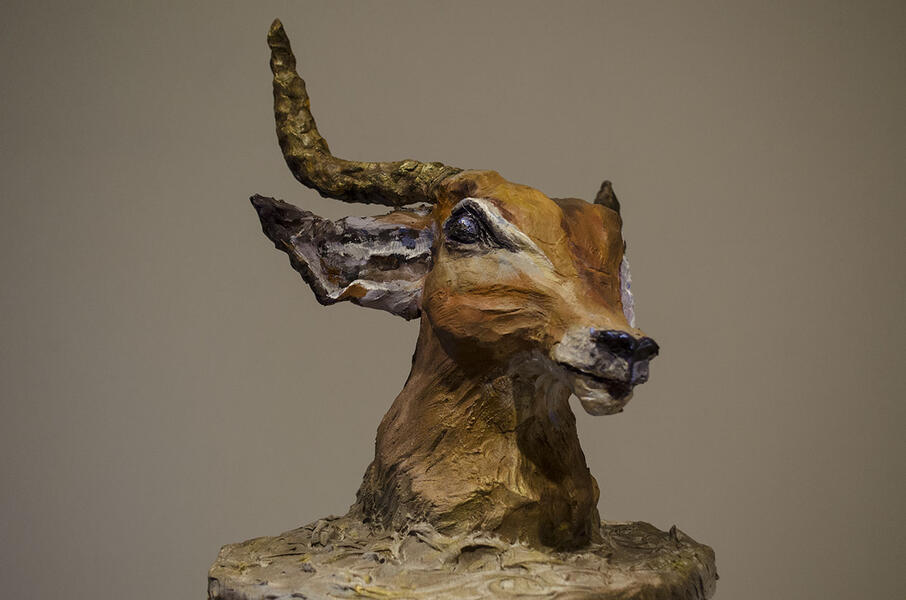 Impala Trophy (Detail)Hunters display the animals they kill as a form of home decor, thus creating a trophy out of a once living creature. I have created a series of "trophies" that show how ingrained all elements of the creature are with each other with a focus on their anatomy. Elements of their natural environment are present within the piece, thus showing the integration of the animal within nature. This piece represents the hunting of the African Impala for use of their horns.
Impala Trophy (Detail)Hunters display the animals they kill as a form of home decor, thus creating a trophy out of a once living creature. I have created a series of "trophies" that show how ingrained all elements of the creature are with each other with a focus on their anatomy. Elements of their natural environment are present within the piece, thus showing the integration of the animal within nature. This piece represents the hunting of the African Impala for use of their horns. -
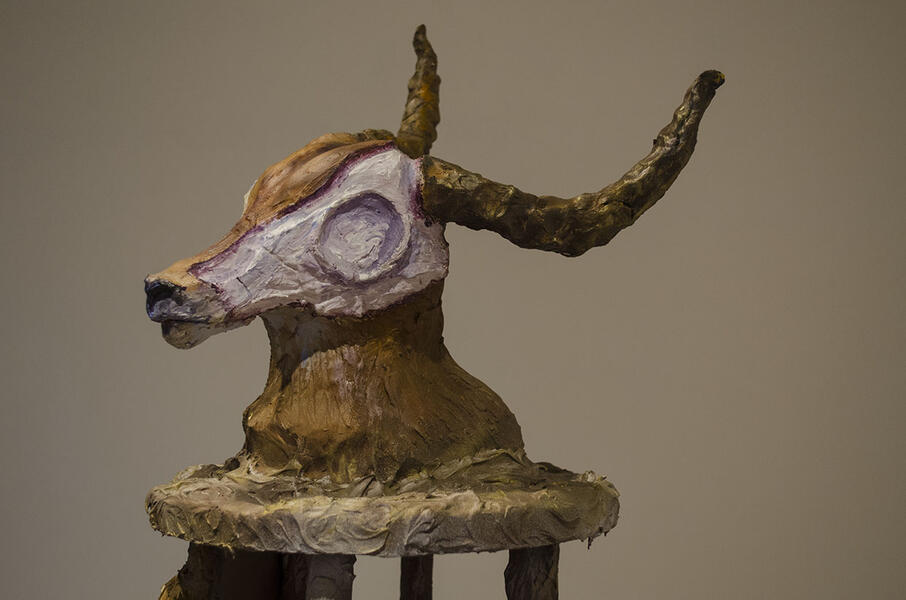 Impala Trophy (Detail)Hunters display the animals they kill as a form of home decor, thus creating a trophy out of a once living creature. I have created a series of "trophies" that show how ingrained all elements of the creature are with each other with a focus on their anatomy. Elements of their natural environment are present within the piece, thus showing the integration of the animal within nature. This piece represents the hunting of the African Impala for use of their horns.
Impala Trophy (Detail)Hunters display the animals they kill as a form of home decor, thus creating a trophy out of a once living creature. I have created a series of "trophies" that show how ingrained all elements of the creature are with each other with a focus on their anatomy. Elements of their natural environment are present within the piece, thus showing the integration of the animal within nature. This piece represents the hunting of the African Impala for use of their horns. -
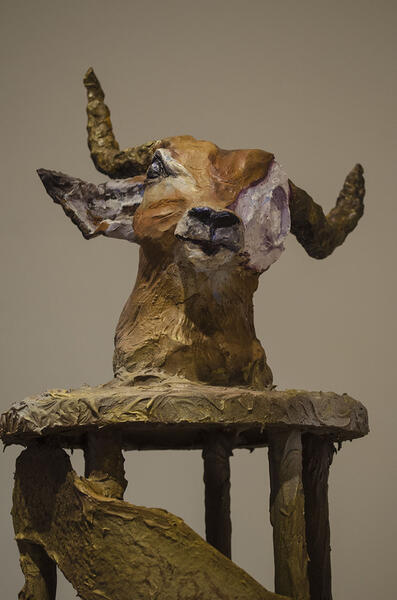 Impala Trophy (Detail)Hunters display the animals they kill as a form of home decor, thus creating a trophy out of a once living creature. I have created a series of "trophies" that show how ingrained all elements of the creature are with each other with a focus on their anatomy. Elements of their natural environment are present within the piece, thus showing the integration of the animal within nature. This piece represents the hunting of the African Impala for use of their horns.
Impala Trophy (Detail)Hunters display the animals they kill as a form of home decor, thus creating a trophy out of a once living creature. I have created a series of "trophies" that show how ingrained all elements of the creature are with each other with a focus on their anatomy. Elements of their natural environment are present within the piece, thus showing the integration of the animal within nature. This piece represents the hunting of the African Impala for use of their horns. -
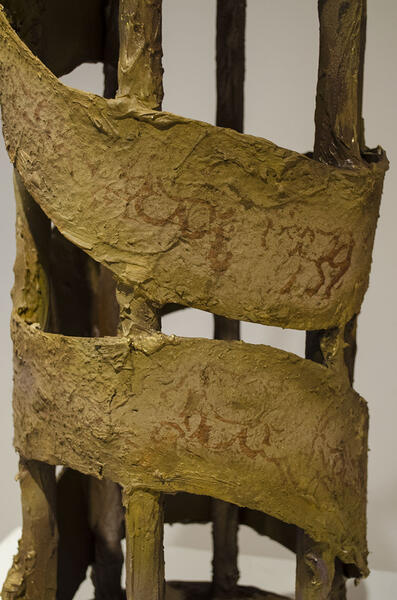 Impala Trophy (Detail)Hunters display the animals they kill as a form of home decor, thus creating a trophy out of a once living creature. I have created a series of "trophies" that show how ingrained all elements of the creature are with each other with a focus on their anatomy. Elements of their natural environment are present within the piece, thus showing the integration of the animal within nature. This piece represents the hunting of the African Impala for use of their horns.
Impala Trophy (Detail)Hunters display the animals they kill as a form of home decor, thus creating a trophy out of a once living creature. I have created a series of "trophies" that show how ingrained all elements of the creature are with each other with a focus on their anatomy. Elements of their natural environment are present within the piece, thus showing the integration of the animal within nature. This piece represents the hunting of the African Impala for use of their horns.
Gorilla Trophy
Hunters display the animals they kill as a form of home decor, thus creating a trophy out of a once living creature. I have created a series of "trophies" that show how ingrained all elements of the creature are with each other with a focus on their anatomy. Elements of their natural environment are present within the piece, thus showing the integration of the animal within nature.
This piece represents the hunting of gorillas for use of their hands, which some cultures falsely believe contain medicinal properties.
-
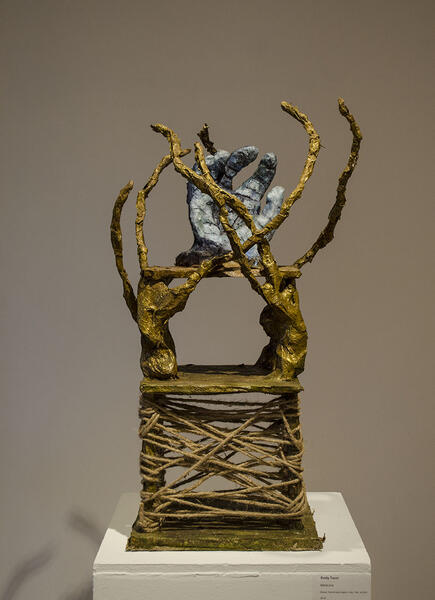 Gorilla TrophyHunters display the animals they kill as a form of home decor, thus creating a trophy out of a once living creature. I have created a series of "trophies" that show how ingrained all elements of the creature are with each other with a focus on their anatomy. Elements of their natural environment are present within the piece, thus showing the integration of the animal within nature. This piece represents the hunting of gorillas for use of their hands, which some cultures falsely believe contain medicinal properties. Wood, hand made paper made with dead leaves, clay, hair, spray paint, acrylic, hemp
Gorilla TrophyHunters display the animals they kill as a form of home decor, thus creating a trophy out of a once living creature. I have created a series of "trophies" that show how ingrained all elements of the creature are with each other with a focus on their anatomy. Elements of their natural environment are present within the piece, thus showing the integration of the animal within nature. This piece represents the hunting of gorillas for use of their hands, which some cultures falsely believe contain medicinal properties. Wood, hand made paper made with dead leaves, clay, hair, spray paint, acrylic, hemp -
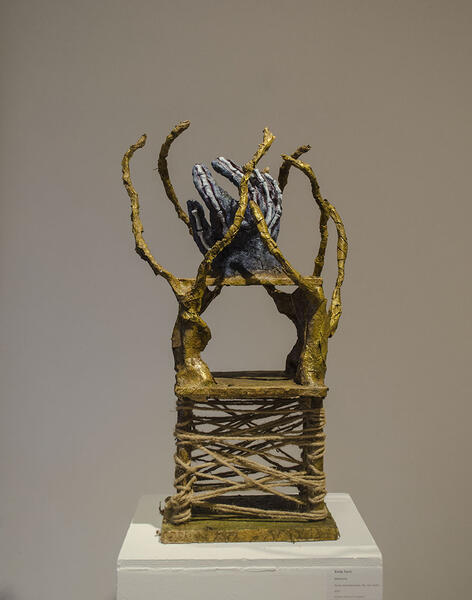 Gorilla Trophy (Detail)Hunters display the animals they kill as a form of home decor, thus creating a trophy out of a once living creature. I have created a series of "trophies" that show how ingrained all elements of the creature are with each other with a focus on their anatomy. Elements of their natural environment are present within the piece, thus showing the integration of the animal within nature. This piece represents the hunting of gorillas for use of their hands, which some cultures falsely believe contain medicinal properties.
Gorilla Trophy (Detail)Hunters display the animals they kill as a form of home decor, thus creating a trophy out of a once living creature. I have created a series of "trophies" that show how ingrained all elements of the creature are with each other with a focus on their anatomy. Elements of their natural environment are present within the piece, thus showing the integration of the animal within nature. This piece represents the hunting of gorillas for use of their hands, which some cultures falsely believe contain medicinal properties. -
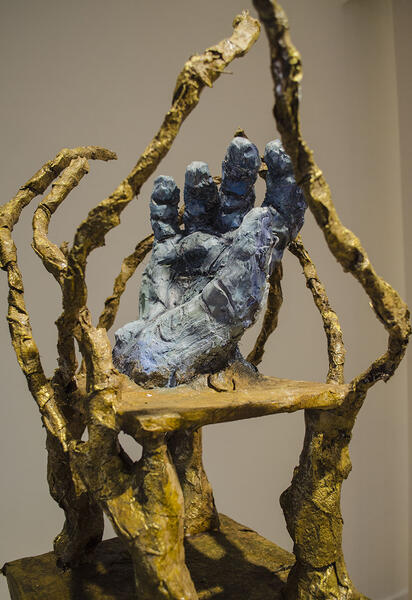 Gorilla Trophy (Detail)Hunters display the animals they kill as a form of home decor, thus creating a trophy out of a once living creature. I have created a series of "trophies" that show how ingrained all elements of the creature are with each other with a focus on their anatomy. Elements of their natural environment are present within the piece, thus showing the integration of the animal within nature. This piece represents the hunting of gorillas for use of their hands, which some cultures falsely believe contain medicinal properties.
Gorilla Trophy (Detail)Hunters display the animals they kill as a form of home decor, thus creating a trophy out of a once living creature. I have created a series of "trophies" that show how ingrained all elements of the creature are with each other with a focus on their anatomy. Elements of their natural environment are present within the piece, thus showing the integration of the animal within nature. This piece represents the hunting of gorillas for use of their hands, which some cultures falsely believe contain medicinal properties. -
 Gorilla Trophy (Detail)Hunters display the animals they kill as a form of home decor, thus creating a trophy out of a once living creature. I have created a series of "trophies" that show how ingrained all elements of the creature are with each other with a focus on their anatomy. Elements of their natural environment are present within the piece, thus showing the integration of the animal within nature. This piece represents the hunting of gorillas for use of their hands, which some cultures falsely believe contain medicinal properties.
Gorilla Trophy (Detail)Hunters display the animals they kill as a form of home decor, thus creating a trophy out of a once living creature. I have created a series of "trophies" that show how ingrained all elements of the creature are with each other with a focus on their anatomy. Elements of their natural environment are present within the piece, thus showing the integration of the animal within nature. This piece represents the hunting of gorillas for use of their hands, which some cultures falsely believe contain medicinal properties. -
 Gorilla Trophy 8.jpgHunters display the animals they kill as a form of home decor, thus creating a trophy out of a once living creature. I have created a series of "trophies" that show how ingrained all elements of the creature are with each other with a focus on their anatomy. Elements of their natural environment are present within the piece, thus showing the integration of the animal within nature. This piece represents the hunting of gorillas for use of their hands, which some cultures falsely believe contain medicinal properties.
Gorilla Trophy 8.jpgHunters display the animals they kill as a form of home decor, thus creating a trophy out of a once living creature. I have created a series of "trophies" that show how ingrained all elements of the creature are with each other with a focus on their anatomy. Elements of their natural environment are present within the piece, thus showing the integration of the animal within nature. This piece represents the hunting of gorillas for use of their hands, which some cultures falsely believe contain medicinal properties.
Elephant Trophy
Hunters display the animals they kill as a form of home decor, thus creating a trophy out of a once living creature. I have created a series of "trophies" that show how ingrained all elements of the creature are with each other with a focus on their anatomy. Elements of their natural environment are present within the piece, thus showing the integration of the animal within nature.
This piece represents the hunting of elephants for their tusks.
-
 Elephant TrophyHunters display the animals they kill as a form of home decor, thus creating a trophy out of a once living creature. I have created a series of "trophies" that show how ingrained all elements of the creature are with each other with a focus on their anatomy. Elements of their natural environment are present within the piece, thus showing the integration of the animal within nature. This piece represents the hunting of elephants for their tusks. Wood, sand clay, plexi glass, clay, acrylic, sand
Elephant TrophyHunters display the animals they kill as a form of home decor, thus creating a trophy out of a once living creature. I have created a series of "trophies" that show how ingrained all elements of the creature are with each other with a focus on their anatomy. Elements of their natural environment are present within the piece, thus showing the integration of the animal within nature. This piece represents the hunting of elephants for their tusks. Wood, sand clay, plexi glass, clay, acrylic, sand -
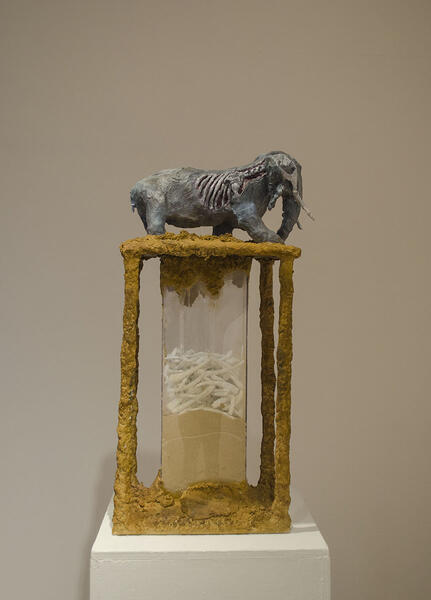 Elephant Trophy (Detail)Hunters display the animals they kill as a form of home decor, thus creating a trophy out of a once living creature. I have created a series of "trophies" that show how ingrained all elements of the creature are with each other with a focus on their anatomy. Elements of their natural environment are present within the piece, thus showing the integration of the animal within nature. This piece represents the hunting of elephants for their tusks.
Elephant Trophy (Detail)Hunters display the animals they kill as a form of home decor, thus creating a trophy out of a once living creature. I have created a series of "trophies" that show how ingrained all elements of the creature are with each other with a focus on their anatomy. Elements of their natural environment are present within the piece, thus showing the integration of the animal within nature. This piece represents the hunting of elephants for their tusks. -
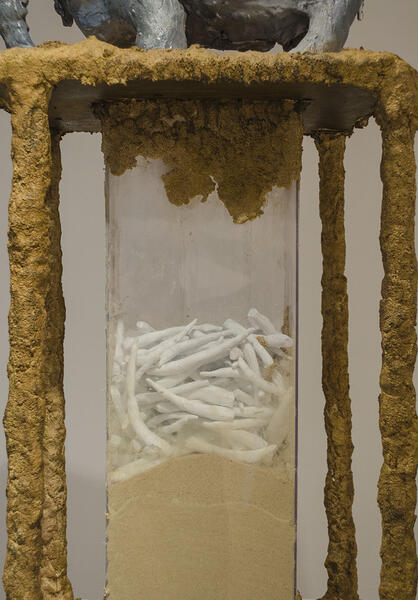 Elephant Trophy (Detail)Hunters display the animals they kill as a form of home decor, thus creating a trophy out of a once living creature. I have created a series of "trophies" that show how ingrained all elements of the creature are with each other with a focus on their anatomy. Elements of their natural environment are present within the piece, thus showing the integration of the animal within nature. This piece represents the hunting of elephants for their tusks.
Elephant Trophy (Detail)Hunters display the animals they kill as a form of home decor, thus creating a trophy out of a once living creature. I have created a series of "trophies" that show how ingrained all elements of the creature are with each other with a focus on their anatomy. Elements of their natural environment are present within the piece, thus showing the integration of the animal within nature. This piece represents the hunting of elephants for their tusks. -
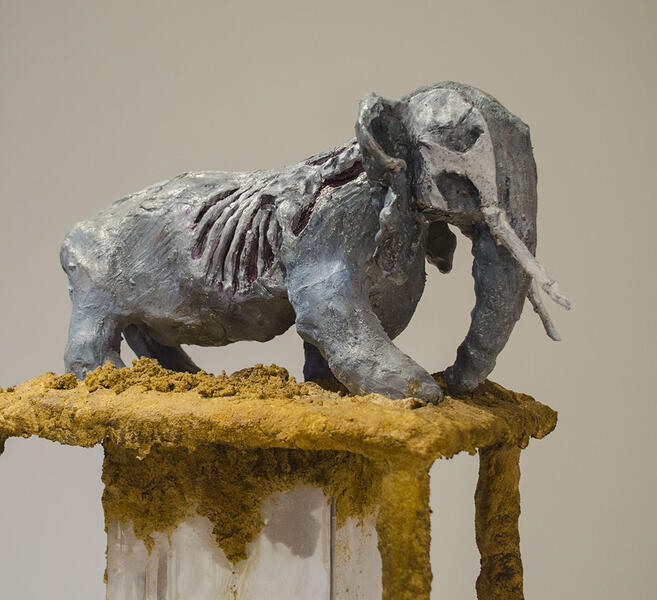 Elephant Trophy (Detail)Hunters display the animals they kill as a form of home decor, thus creating a trophy out of a once living creature. I have created a series of "trophies" that show how ingrained all elements of the creature are with each other with a focus on their anatomy. Elements of their natural environment are present within the piece, thus showing the integration of the animal within nature. This piece represents the hunting of elephants for their tusks.
Elephant Trophy (Detail)Hunters display the animals they kill as a form of home decor, thus creating a trophy out of a once living creature. I have created a series of "trophies" that show how ingrained all elements of the creature are with each other with a focus on their anatomy. Elements of their natural environment are present within the piece, thus showing the integration of the animal within nature. This piece represents the hunting of elephants for their tusks.
Horns
Hunters display the animals they kill as a form of home decor, thus creating a trophy out of a once living creature. I have created a series of "trophies" that show how ingrained all elements of the creature are with each other with a focus on their anatomy. Elements of their natural environment are present within the piece, thus showing the integration of the animal within nature.
This piece represents the hunting of impalas and antelope for their horns, which are often mounted and displayed.
-
 HornsHunters display the animals they kill as a form of home decor, thus creating a trophy out of a once living creature. I have created a series of "trophies" that show how ingrained all elements of the creature are with each other with a focus on their anatomy. Elements of their natural environment are present within the piece, thus showing the integration of the animal within nature. This piece represents the hunting of impalas and antelope for their horns, which are often mounted and displayed. Wood, joint compound, clay, spray paint, acrylic
HornsHunters display the animals they kill as a form of home decor, thus creating a trophy out of a once living creature. I have created a series of "trophies" that show how ingrained all elements of the creature are with each other with a focus on their anatomy. Elements of their natural environment are present within the piece, thus showing the integration of the animal within nature. This piece represents the hunting of impalas and antelope for their horns, which are often mounted and displayed. Wood, joint compound, clay, spray paint, acrylic -
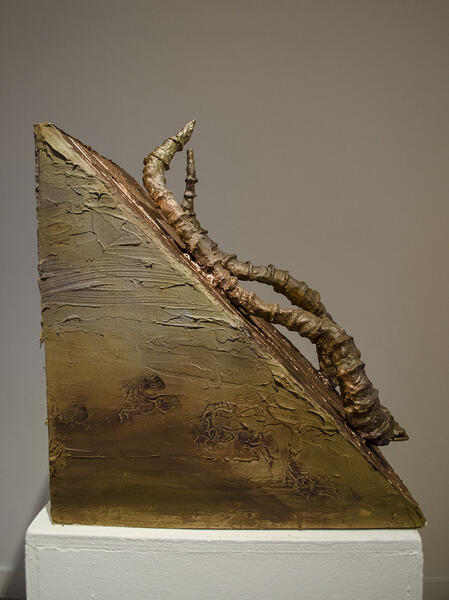 Horns (Detail)Hunters display the animals they kill as a form of home decor, thus creating a trophy out of a once living creature. I have created a series of "trophies" that show how ingrained all elements of the creature are with each other with a focus on their anatomy. Elements of their natural environment are present within the piece, thus showing the integration of the animal within nature. This piece represents the hunting of impalas and antelope for their horns, which are often mounted and displayed.
Horns (Detail)Hunters display the animals they kill as a form of home decor, thus creating a trophy out of a once living creature. I have created a series of "trophies" that show how ingrained all elements of the creature are with each other with a focus on their anatomy. Elements of their natural environment are present within the piece, thus showing the integration of the animal within nature. This piece represents the hunting of impalas and antelope for their horns, which are often mounted and displayed. -
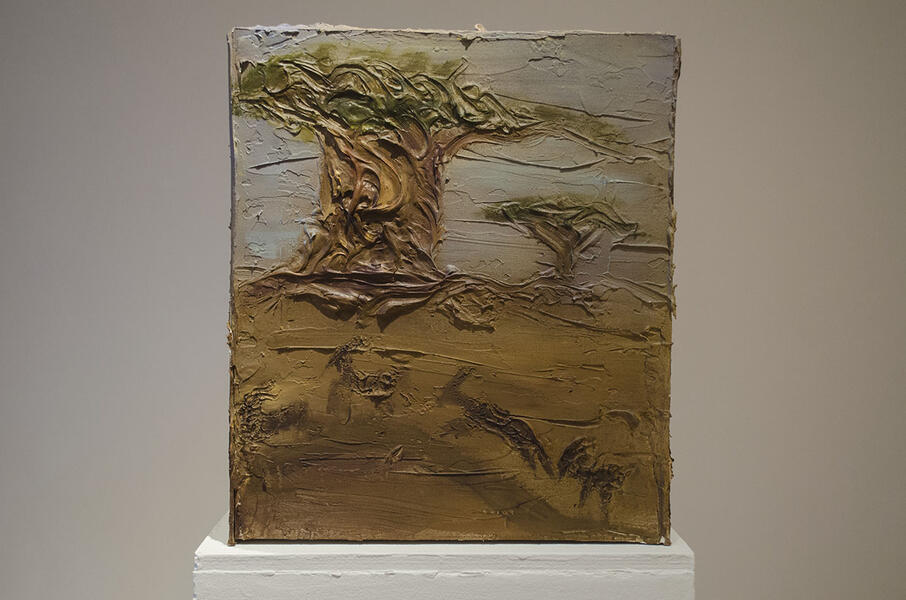 Horns (Detail)Hunters display the animals they kill as a form of home decor, thus creating a trophy out of a once living creature. I have created a series of "trophies" that show how ingrained all elements of the creature are with each other with a focus on their anatomy. Elements of their natural environment are present within the piece, thus showing the integration of the animal within nature. This piece represents the hunting of impalas and antelope for their horns, which are often mounted and displayed.
Horns (Detail)Hunters display the animals they kill as a form of home decor, thus creating a trophy out of a once living creature. I have created a series of "trophies" that show how ingrained all elements of the creature are with each other with a focus on their anatomy. Elements of their natural environment are present within the piece, thus showing the integration of the animal within nature. This piece represents the hunting of impalas and antelope for their horns, which are often mounted and displayed.
Reduced
Elephants are valued most for their ivory tusks. The complexity and variation of this creature is overlooked and reduced to simply the value of these tusks. This piece is a reflection of this reduction, with the tusks beginning to vanish in their translucent state. They are both incredibly present, yet missing.
Wood, joint compound, tape, spray paint
Wood, joint compound, tape, spray paint
-
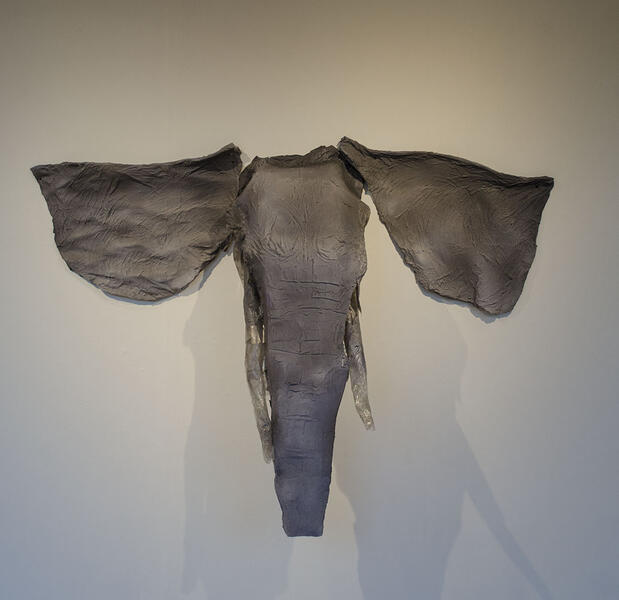 ReducedElephants are valued most for their ivory tusks. The complexity and variation of this creature is overlooked and reduced to simply the value of these tusks. This piece is a reflection of this reduction, with the tusks beginning to vanish in their translucent state. They are both incredibly present, yet missing.
ReducedElephants are valued most for their ivory tusks. The complexity and variation of this creature is overlooked and reduced to simply the value of these tusks. This piece is a reflection of this reduction, with the tusks beginning to vanish in their translucent state. They are both incredibly present, yet missing. -
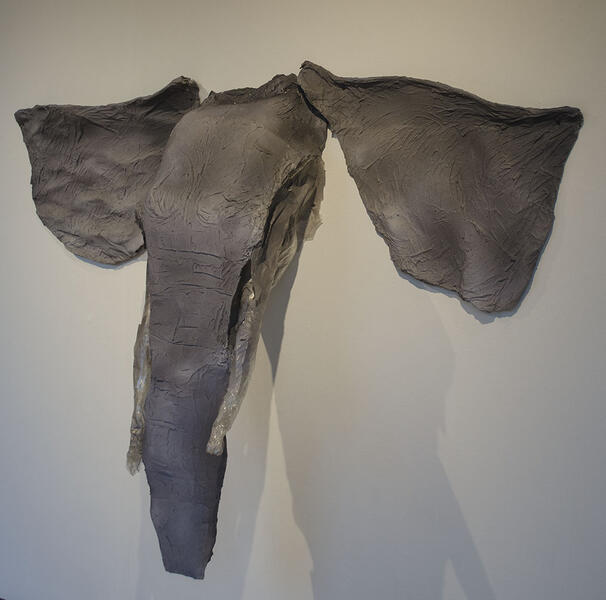 Reduced (Detail)Detail of Reduced: Elephants are valued most for their ivory tusks. The complexity and variation of this creature is overlooked and reduced to simply the value of these tusks. This piece is a reflection of this reduction, with the tusks beginning to vanish in their translucent state. They are both incredibly present, yet missing.
Reduced (Detail)Detail of Reduced: Elephants are valued most for their ivory tusks. The complexity and variation of this creature is overlooked and reduced to simply the value of these tusks. This piece is a reflection of this reduction, with the tusks beginning to vanish in their translucent state. They are both incredibly present, yet missing.
Not Up to Standard
Due to inhumane and irresponsible breeding techniques, many purebred dogs suffer from genetic disorders. This results in their being deemed "not up to standard" according to the American Kennel Club. This piece reflects the negative effects of genetic breeding on five breeds, including bulldogs, pugs, dobermans, dalmatians, and bloodhounds. They suffer from difficulty breathing, cataracts, pinned ears, skin rashes, and drooping skin around the eyes that lead to infection.
Clay, wood, acrylic
Clay, wood, acrylic
-
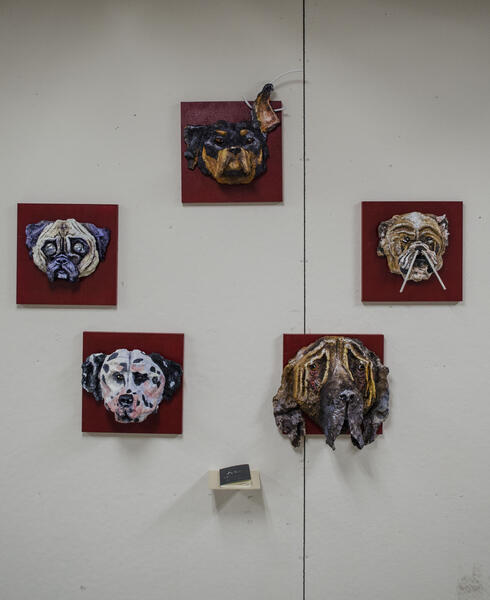 Not Up to StandardDue to inhumane and irresponsible breeding techniques, many purebred dogs suffer from genetic disorders. This results in their being deemed "not up to standard" according to the American Kennel Club. This piece reflects the negative effects of genetic breeding on five breeds, including bulldogs, pugs, dobermans, dalmatians, and bloodhounds. They suffer from difficulty breathing, cataracts, pinned ears, skin rashes, and drooping skin around the eyes that lead to infection.
Not Up to StandardDue to inhumane and irresponsible breeding techniques, many purebred dogs suffer from genetic disorders. This results in their being deemed "not up to standard" according to the American Kennel Club. This piece reflects the negative effects of genetic breeding on five breeds, including bulldogs, pugs, dobermans, dalmatians, and bloodhounds. They suffer from difficulty breathing, cataracts, pinned ears, skin rashes, and drooping skin around the eyes that lead to infection. -
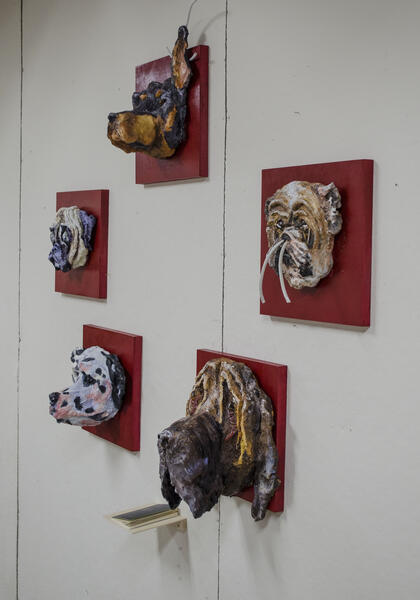 Not Up to Standard (Detail)Due to inhumane and irresponsible breeding techniques, many purebred dogs suffer from genetic disorders. This results in their being deemed "not up to standard" according to the American Kennel Club. This piece reflects the negative effects of genetic breeding on five breeds, including bulldogs, pugs, dobermans, dalmatians, and bloodhounds. They suffer from difficulty breathing, cataracts, pinned ears, skin rashes, and drooping skin around the eyes that lead to infection.
Not Up to Standard (Detail)Due to inhumane and irresponsible breeding techniques, many purebred dogs suffer from genetic disorders. This results in their being deemed "not up to standard" according to the American Kennel Club. This piece reflects the negative effects of genetic breeding on five breeds, including bulldogs, pugs, dobermans, dalmatians, and bloodhounds. They suffer from difficulty breathing, cataracts, pinned ears, skin rashes, and drooping skin around the eyes that lead to infection. -
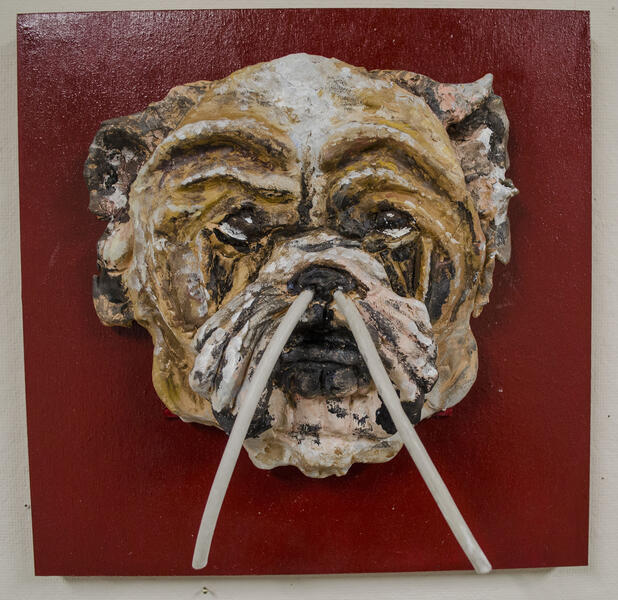 Not Up to Standard (Bulldog)Due to inhumane and irresponsible breeding techniques, many purebred dogs suffer from genetic disorders. This results in their being deemed "not up to standard" according to the American Kennel Club. This piece reflects the negative effects of genetic breeding on five breeds, including bulldogs, pugs, dobermans, dalmatians, and bloodhounds. They suffer from difficulty breathing, cataracts, pinned ears, skin rashes, and drooping skin around the eyes that lead to infection.
Not Up to Standard (Bulldog)Due to inhumane and irresponsible breeding techniques, many purebred dogs suffer from genetic disorders. This results in their being deemed "not up to standard" according to the American Kennel Club. This piece reflects the negative effects of genetic breeding on five breeds, including bulldogs, pugs, dobermans, dalmatians, and bloodhounds. They suffer from difficulty breathing, cataracts, pinned ears, skin rashes, and drooping skin around the eyes that lead to infection. -
 Not Up to Standard (Pug)Due to inhumane and irresponsible breeding techniques, many purebred dogs suffer from genetic disorders. This results in their being deemed "not up to standard" according to the American Kennel Club. This piece reflects the negative effects of genetic breeding on five breeds, including bulldogs, pugs, dobermans, dalmatians, and bloodhounds. They suffer from difficulty breathing, cataracts, pinned ears, skin rashes, and drooping skin around the eyes that lead to infection.
Not Up to Standard (Pug)Due to inhumane and irresponsible breeding techniques, many purebred dogs suffer from genetic disorders. This results in their being deemed "not up to standard" according to the American Kennel Club. This piece reflects the negative effects of genetic breeding on five breeds, including bulldogs, pugs, dobermans, dalmatians, and bloodhounds. They suffer from difficulty breathing, cataracts, pinned ears, skin rashes, and drooping skin around the eyes that lead to infection. -
 Not Up to Standard (Doberman)Due to inhumane and irresponsible breeding techniques, many purebred dogs suffer from genetic disorders. This results in their being deemed "not up to standard" according to the American Kennel Club. This piece reflects the negative effects of genetic breeding on five breeds, including bulldogs, pugs, dobermans, dalmatians, and bloodhounds. They suffer from difficulty breathing, cataracts, pinned ears, skin rashes, and drooping skin around the eyes that lead to infection.
Not Up to Standard (Doberman)Due to inhumane and irresponsible breeding techniques, many purebred dogs suffer from genetic disorders. This results in their being deemed "not up to standard" according to the American Kennel Club. This piece reflects the negative effects of genetic breeding on five breeds, including bulldogs, pugs, dobermans, dalmatians, and bloodhounds. They suffer from difficulty breathing, cataracts, pinned ears, skin rashes, and drooping skin around the eyes that lead to infection. -
 Not Up to Standard (Dalmatian)Due to inhumane and irresponsible breeding techniques, many purebred dogs suffer from genetic disorders. This results in their being deemed "not up to standard" according to the American Kennel Club. This piece reflects the negative effects of genetic breeding on five breeds, including bulldogs, pugs, dobermans, dalmatians, and bloodhounds. They suffer from difficulty breathing, cataracts, pinned ears, skin rashes, and drooping skin around the eyes that lead to infection.
Not Up to Standard (Dalmatian)Due to inhumane and irresponsible breeding techniques, many purebred dogs suffer from genetic disorders. This results in their being deemed "not up to standard" according to the American Kennel Club. This piece reflects the negative effects of genetic breeding on five breeds, including bulldogs, pugs, dobermans, dalmatians, and bloodhounds. They suffer from difficulty breathing, cataracts, pinned ears, skin rashes, and drooping skin around the eyes that lead to infection. -
 Not Up to Standard (Bloodhound)Due to inhumane and irresponsible breeding techniques, many purebred dogs suffer from genetic disorders. This results in their being deemed "not up to standard" according to the American Kennel Club. This piece reflects the negative effects of genetic breeding on five breeds, including bulldogs, pugs, dobermans, dalmatians, and bloodhounds. They suffer from difficulty breathing, cataracts, pinned ears, skin rashes, and drooping skin around the eyes that lead to infection.
Not Up to Standard (Bloodhound)Due to inhumane and irresponsible breeding techniques, many purebred dogs suffer from genetic disorders. This results in their being deemed "not up to standard" according to the American Kennel Club. This piece reflects the negative effects of genetic breeding on five breeds, including bulldogs, pugs, dobermans, dalmatians, and bloodhounds. They suffer from difficulty breathing, cataracts, pinned ears, skin rashes, and drooping skin around the eyes that lead to infection. -
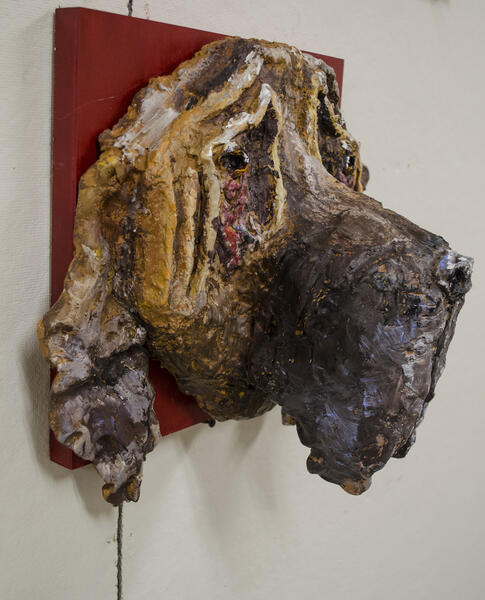 Not Up to Standard (Bloodhound Detail)Due to inhumane and irresponsible breeding techniques, many purebred dogs suffer from genetic disorders. This results in their being deemed "not up to standard" according to the American Kennel Club. This piece reflects the negative effects of genetic breeding on five breeds, including bulldogs, pugs, dobermans, dalmatians, and bloodhounds. They suffer from difficulty breathing, cataracts, pinned ears, skin rashes, and drooping skin around the eyes that lead to infection.
Not Up to Standard (Bloodhound Detail)Due to inhumane and irresponsible breeding techniques, many purebred dogs suffer from genetic disorders. This results in their being deemed "not up to standard" according to the American Kennel Club. This piece reflects the negative effects of genetic breeding on five breeds, including bulldogs, pugs, dobermans, dalmatians, and bloodhounds. They suffer from difficulty breathing, cataracts, pinned ears, skin rashes, and drooping skin around the eyes that lead to infection.
Animal Illustrations
A series of wildlife illustrations that seeks to represent the inherent beauty of the creatures and their environment
-
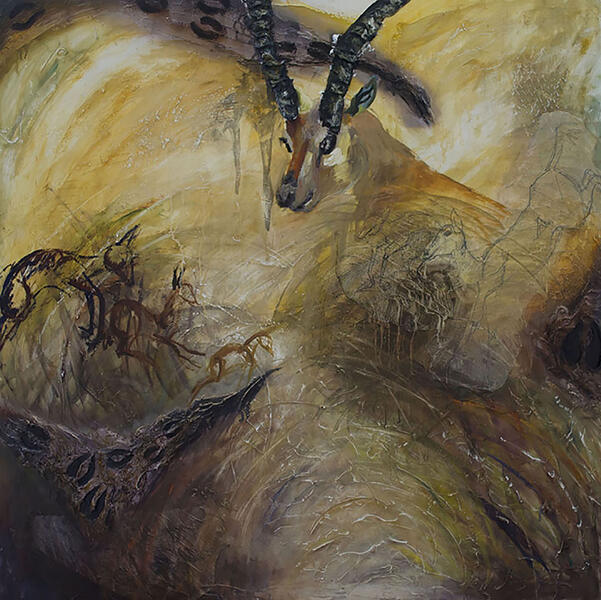 Gazelle EnvironmentAcrylic, oil, modeling paste, paper, and pen on wood 4' x 4'
Gazelle EnvironmentAcrylic, oil, modeling paste, paper, and pen on wood 4' x 4' -
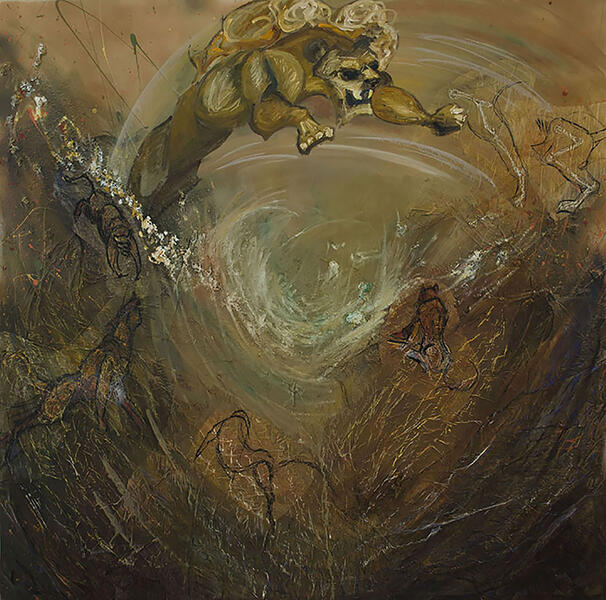 Lion EnvironmentAcrylic, oil, paper, pen, and grout on wood 4' x 4'
Lion EnvironmentAcrylic, oil, paper, pen, and grout on wood 4' x 4' -
 Elephant EnvironmentAcrylic, oil, paper, spackle, and grout on wood 4' x 4'
Elephant EnvironmentAcrylic, oil, paper, spackle, and grout on wood 4' x 4' -
 Charging RhinoAcrylic, spray paint, and cat litter on canvas 30'' x 36''
Charging RhinoAcrylic, spray paint, and cat litter on canvas 30'' x 36'' -
 Silverback GorillaPastel on paper 22'' x 30''
Silverback GorillaPastel on paper 22'' x 30'' -
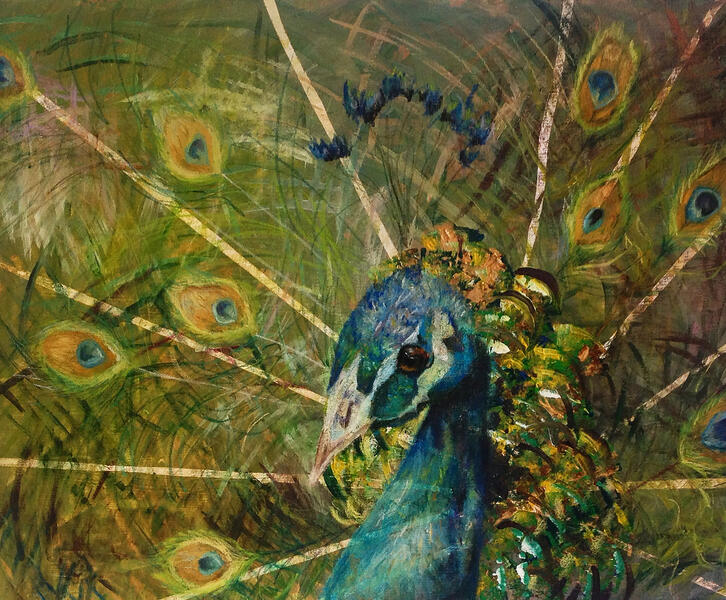 PeacockAcrylic and pastel on canvas 24'' x 18''
PeacockAcrylic and pastel on canvas 24'' x 18'' -
 Mother and ChildAn illustration of the relationship between a mother elephant and her young calf in the Tanzanian savanna Pastel on paper 22'' x 30''
Mother and ChildAn illustration of the relationship between a mother elephant and her young calf in the Tanzanian savanna Pastel on paper 22'' x 30'' -
 MigrationAn illustration of the gestures of the wildebeest as it migrates through Tanzania Pen and watercolor on paper 30'' x 11''
MigrationAn illustration of the gestures of the wildebeest as it migrates through Tanzania Pen and watercolor on paper 30'' x 11''









